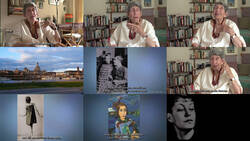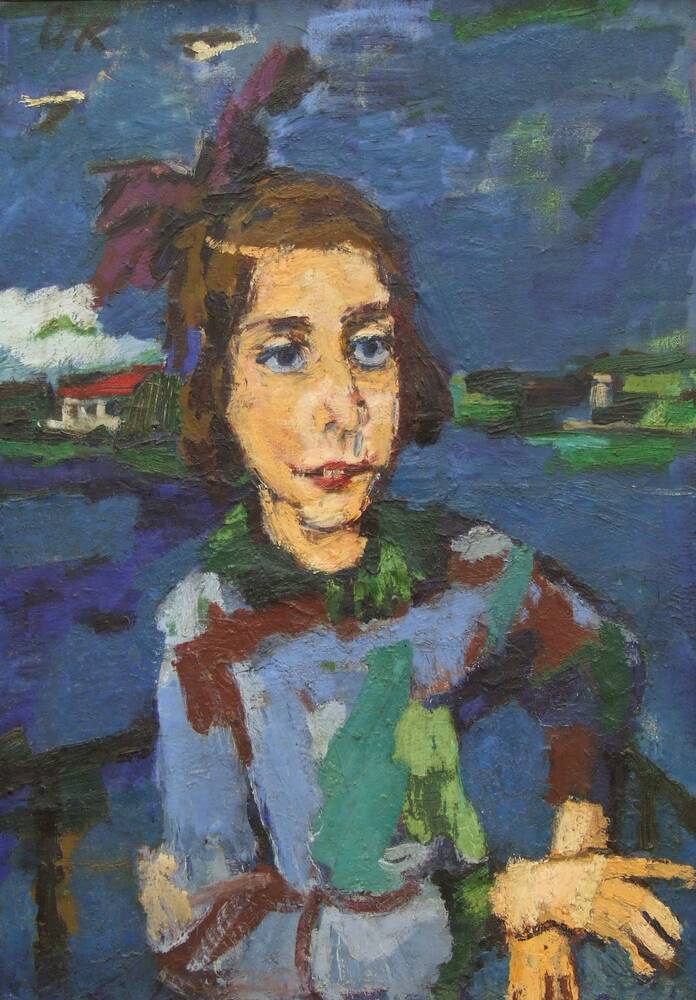“For Kokoschka, children are very special. They are valuable, they are bearers of experience, and they experience things very intensively...”
In 1921, Oskar Kokoschka painted a portrait of Gitta Wallerstein, daughter of an art dealer friend of his. At that time, Kokoschka was 35, the youngest professor at the Dresden Academy of Art, his wild years as the enfant terrible of the Vienna art scene behind him. Now, the portraits he was painting are almost psychological profiles of his sitters. This work, for instance, reflects the shy and earnest gaze of a young girl approaching adolescence. Kokoschka has painted Gitta in luminous blue and green tones in front of a broad river landscape. Curator Birgit Dalbajewa again:
"Gitta Wallerstein was ten years old when she sat for Kokoschka in his art academy studio on the Brühlsche Terrasse next to the Albertinum. Later, she recalled how incredibly nervous she was with this man with his Viennese accent. Since she was allowed to perform her gym exercises in his studio, she could move freely. From time to time, Kokoschka took a tube of colour, held it against her dress and asked her quite seriously whether, in her view, she thought the colour was the right one.”
In those days, Gitta Wallerstein was already taking dancing lessons. She went on to become a solo dancer at Berlin’s State Opera House. But since she came from a Jewish family, after the Nazi seizure of power she was banned from performing. In 1939, she emigrated to the USA. There, she initially worked as a dancer, but later became a doctor’s receptionist and a radiology assistant. Until her death in 2008, Gitta Wallerstein worked for human rights and cared for people with HIV/AIDS. She and Oskar Kokoschka remained friends for life.
Further Media
Modern Gallery under Hans Posse
By the end of the First World War, the modern collection in the Dresden Paintings Gallery had acquired Realist, Symbolist, and other such works, but almost no paintings from the latest, cutting-edge art movements – no Gauguin or Van Gogh, and only a few Expressionists. Initially, Paintings Gallery Director Hans Posse was powerless in the face of a conservative acquisitions commission made up of venerable art professors and Saxon’s crown prince – but in 1919, after the collapse of Imperial Germany, that changed radically.
Now, the arts pages in Dresden’s newspapers called for the gallery to be “rejuvenated”. Posse pushed through measures to replace the acquisitions commission with an advisory committee open to progressive ideas. Despite the limited finances available, he gradually built up a collection of modern art, starting with works by Kokoschka, Heckel, and Pechstein. With these works, Posse shaped the Modern Gallery. Above all, from 1925, he could add major works by Munch, Kokoschka, Beckmann and many others to the collection, initially also shown in the Semperbau in the Zwinger. Thanks to the civil society support of a Friends Association, it was also possible to acquire paintings by Klee, Kandinsky and Chagall – although such experimental works were only officially taken into the state collection after a probationary period of ten years.
The tide turned, though, after the Nazi Party came to power in 1933. For a long time, Posse had been attacked by “blood and soil” nationalist circles in Dresden. Under the Nazi regime, he gradually adjusted to the new conditions, taking down many paintings. In 1937, over 50 works were confiscated as “degenerate art” – paintings partly belonging to state gallery, partly to the Friends’ Association, and partly to city of Dresden which supported the Modern Gallery with loans. The following year, Hitler visited the Paintings Gallery. Impressed by Posse’s expertise in works by the Old Masters, Hitler appointed him the Special Envoy for his planned museum project in Linz. For nearly three years until his death in 1942, the works Posse collected for the planned Führer Museum were mostly paintings looted from Jewish owners.
- Location & Dating
- 1921
- Material & Technique
- Oil on canvas
- Dimenions
- 85 x 60 cm (Katalogmaß 2010) 111,5 x 86,7 x 5 cm (Rahmenmaß, Tobias Lange, 26.04.2010)
- Museum
- Galerie Neue Meister
- Inventory number
- Inv.-Nr. 2014/04

